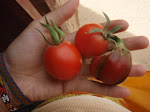 The Aloe is endemic to Africa
The Aloe is endemic to AfricaIt felt really good to survey my work and be commended for it by women whom I respect. After they had seen it all, they had a bunch of questions about an aloe plant that I brought back from Hamdallaye. I explained it is good for burns, and I'll give them some clippings when it's bigger.
I gave Karima a little sapling of a tree I planted--not sure of its name in English--but it's called sa miya in Hausa (literally "put in your sauce"). I guess its leaves are edible, but I have no place for it. Hopefully she will plant it by the lake; she said she wanted it for that reason.
 Meaghan, Claudia, John, and Jessica in a photo taken by Char H. In Tahoua
Meaghan, Claudia, John, and Jessica in a photo taken by Char H. In TahouaChar said this about the trees planted at the lake's edge:
"Babaye is a lake, in the rainy season, that used to be surrounded by trees. The trees were so plentiful that when the colonists came to Tahoua, the villagers ran to the lake and sought cover by climbing the trees. They survived while others did not. You can see by the photo that the trees are now gone, but the the City of Tahoua is now planting trees in the hope of using it as a historic attraction in the future. John gave a wonderful impression of a tree ."








2 comments:
We are happy that Jessica has the opportunity in Niger to practice her modern dancing, as a shrub. (?) Aloe has cooling properties, which should be good for the desert and mosquito bites.
Yes, there has been little opportunity for modern dance so far there in Niger. It's a little unclear what they are acting out in the photo...shrubs? short trees? cleverly hidden villagers? And you're right: the aloe will be another weapon in the arsenal against mosquito bites!
Post a Comment